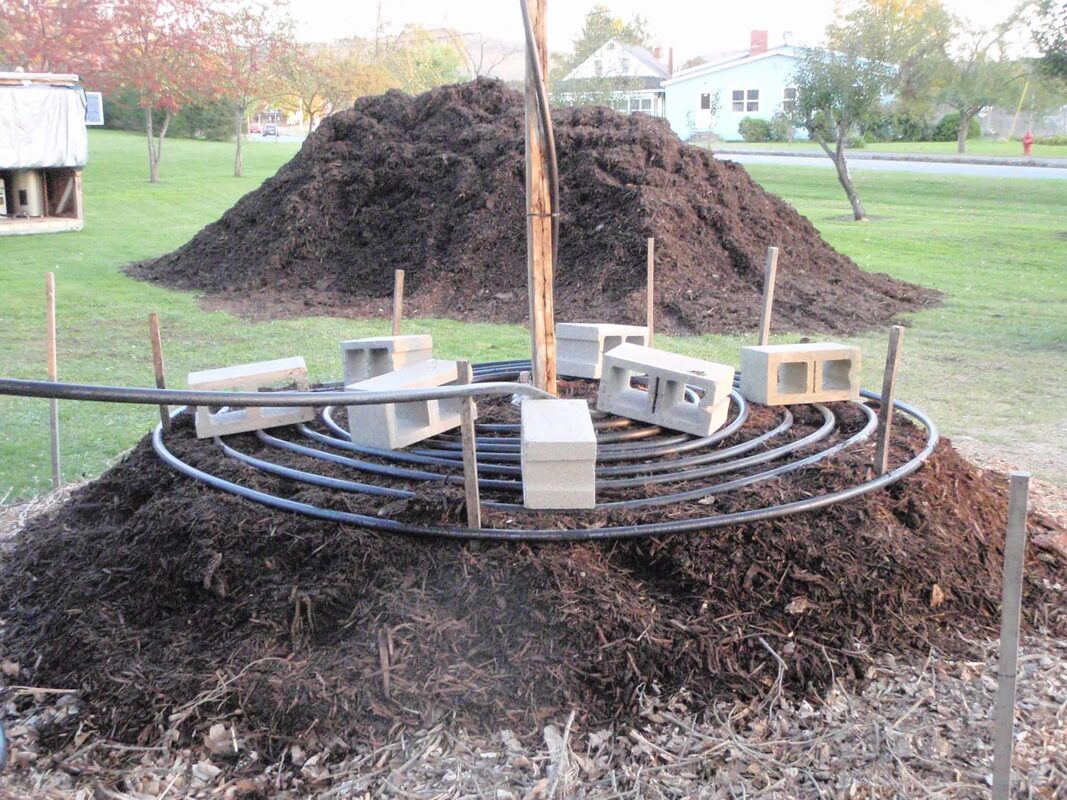Composter Heat Exchanger.

Building a Heat transfer composter.
Compost is the epitome of the perma-culture processes, The rule of thumb in perma-culture is that every thing should have 3 uses, Food is grown providing energy, it is then passed into waste where it is then turned back into energy and heat by microbes and then into fertilizer where it is then used again to grow more food.
Compost is made up of biodegradable materials such as food wast, manure, vegetation and other natural matter that breaks down quickly. Temperatures of a 160 degrees can be obtained with a Compost Heat Exchanger making this an excellent source of energy for heating water. Piles of waste are placed over a holding tank or hoses, as the organic matter decomposes it gives off heat as proteins break down microbiologicaly, that heat is transferred to the hose/coil or tank. The whole thing revolves around microbiology and the cycle of the microbes involved but you don't need to know all of that, it wouldn't hurt but it is not necessary. Reaching the temperatures that is does it creates what you could call a sanitary situation free of odor and insects and pathogens. It works in a similar manner as geo-thermal does but in a different process, but the principles are the same in the manner that a series of tubes or coils filled with water or fluid are ran through the source of heat thereby transferring the energy to another destination. This hot water can be used for heating floors in homes or green houses or for showers and cleaning for free after installation. Geo-thermal takes its heat source from the earth where as this is a chemical breakdown and after it is finished breaking down the compost will need to be replaced, depending on your set up this can be anywhere from 6 months to 3 years. Not bad for free huh! Temperatures will also very but these are things you will figure out and eventually you will find the wright mixture and position to stabilize the system. Life is just a chemical reaction or interaction if you will, in all of its aspects and on every level, harness the action and you get to keep the energy. Unlike solar this energy is 24-7 and when coupled with a Biogas system you are off and running from the grid in leaps and bounds, and once the breakdown is complete you have awesome pile of fertilizer ready to provide you with sustenance. If you have the room for such a system on your location this is just a win, win, win,
Links to composting and heat exchange.
DIY-COMPOSTER COMPOST HEAT EXCHANGER CORNEL UNIVERSITY COMPOST-MODERNISM
Jean Pain is the man probably most popular for bringing this source of energy to the publics eye in the 70's, Read his Readers Digest story at Journey to forever >Jean Pain<.
Compost is made up of biodegradable materials such as food wast, manure, vegetation and other natural matter that breaks down quickly. Temperatures of a 160 degrees can be obtained with a Compost Heat Exchanger making this an excellent source of energy for heating water. Piles of waste are placed over a holding tank or hoses, as the organic matter decomposes it gives off heat as proteins break down microbiologicaly, that heat is transferred to the hose/coil or tank. The whole thing revolves around microbiology and the cycle of the microbes involved but you don't need to know all of that, it wouldn't hurt but it is not necessary. Reaching the temperatures that is does it creates what you could call a sanitary situation free of odor and insects and pathogens. It works in a similar manner as geo-thermal does but in a different process, but the principles are the same in the manner that a series of tubes or coils filled with water or fluid are ran through the source of heat thereby transferring the energy to another destination. This hot water can be used for heating floors in homes or green houses or for showers and cleaning for free after installation. Geo-thermal takes its heat source from the earth where as this is a chemical breakdown and after it is finished breaking down the compost will need to be replaced, depending on your set up this can be anywhere from 6 months to 3 years. Not bad for free huh! Temperatures will also very but these are things you will figure out and eventually you will find the wright mixture and position to stabilize the system. Life is just a chemical reaction or interaction if you will, in all of its aspects and on every level, harness the action and you get to keep the energy. Unlike solar this energy is 24-7 and when coupled with a Biogas system you are off and running from the grid in leaps and bounds, and once the breakdown is complete you have awesome pile of fertilizer ready to provide you with sustenance. If you have the room for such a system on your location this is just a win, win, win,
Links to composting and heat exchange.
DIY-COMPOSTER COMPOST HEAT EXCHANGER CORNEL UNIVERSITY COMPOST-MODERNISM
Jean Pain is the man probably most popular for bringing this source of energy to the publics eye in the 70's, Read his Readers Digest story at Journey to forever >Jean Pain<.
Watch a short video on how exchangers work.
|
A large pile of compost sits breaking down and providing energy.
|
Read more about the Cecil mound from Cornell's small farm program. >link<
|
This is a copper tube heat exchange, after the water is heated by running water through the compost pile in tubes it is then delivered to the Heat/Exchange where the heat/energy is then released into the dwelling.
|



